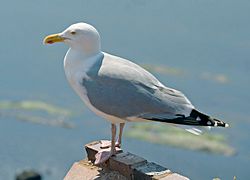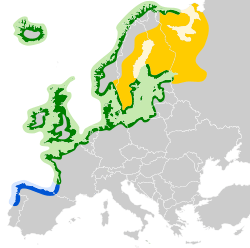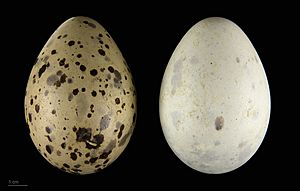Herring gull facts for kids
Quick facts for kids Herring gull |
|
|---|---|
 |
|
| Breeding-plumaged adult on Heligoland | |
| Scientific classification | |
| Kingdom: | |
| Phylum: | |
| Class: | |
| Order: | |
| Family: | |
| Genus: |
Larus
|
| Binomial name | |
| Larus argentatus |
|
 |
|
| Distribution | |
The herring gull (scientific name: Larus argentatus) is a large and common type of gull. These birds can grow up to 66 centimeters (about 26 inches) long! They are very well-known, especially along the coasts of western Europe.
Herring gulls make their homes and raise their young across many parts of Northern Europe, Western Europe, Scandinavia, and the Baltic states. While some gulls fly to warmer places for winter, many stay in areas like the British Isles, Iceland, or near the North Sea. You might even spot them in cities or at garbage dumps, as they are very good at adapting to different environments.
Contents
What They Look Like
Herring gulls are big, strong birds. Adult gulls have light gray backs and white undersides. Their wingtips are black with white spots. They have pink legs and a strong yellow beak with a red spot on the lower part. Young gulls look a bit different. They are mostly brown with darker streaks and spots. It takes them a few years to get their adult feathers.
Where They Live and Travel
Herring gulls are found all over the northern parts of the world. They love coastal areas, but they are also quite common inland. Many gulls live near human towns and cities. They often look for food in places like landfills or even in parks.
Some herring gulls move south for the colder winter months. This journey is called migration. But many gulls, especially those in places like the British Isles, stay in the same area all year round. They are very adaptable birds and can find food in many different places.
Herring Gull Families
Herring gulls usually build their nests on cliffs, rooftops, or even on the ground in safe spots. Both parents help to build the nest and take care of the eggs. A female gull usually lays about three eggs. The parents take turns sitting on the eggs to keep them warm until they hatch. Once the chicks are born, both parents work hard to feed and protect them until they are old enough to fly on their own.
Understanding Gull Types
Scientists sometimes find it tricky to sort out all the different types of gulls. The herring gull is part of a group that includes the lesser black-backed gull. These gulls look quite similar, but they are considered different species. It's a bit like how different dog breeds can look very different but are still dogs. With gulls, there are many small differences that help scientists tell them apart.


